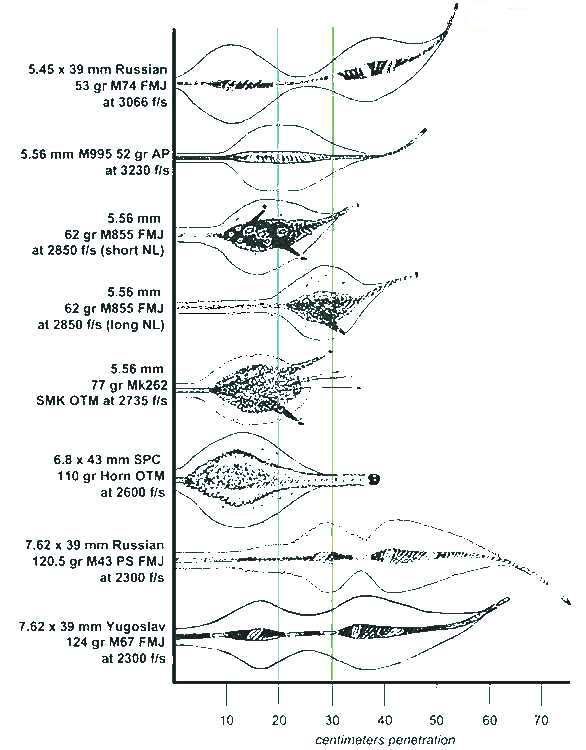M855 doesn't consistently and substantially outpenetrate many handgun rounds, at least not in muscle tissue. The "short NL" (neck length) example shown here is probably somewhat closer to the average wound profile at M4 muzzle velocities, and it's about as deep as many handgun hollowpoints go.
Handgun JHPs designed for deeper penetration like the Critical Duty loadings out of standard service calibers as well as the 10mm 200 gr Gold Dot and HST loadings are likely to push it more into the 15-18" range, closer to the "long NL" M855 profile.
To give some explanation, long NL is what happens when the bullet travels point forward for a longer period of time and takes a while to yaw and fragment; this occurs unpredictably and is more of the minority of situations at M4 muzzle velocities.
Occasionally M855 will simply fail to fragment at all even above its nominal velocity threshold and in this case may attain 20+ inches of penetration, this is far from reliable though (but does occur often enough to make it a rather poor 5.56 hunting/antipersonnel round, at least comparatively). It also results in narrow wounding.
It's possible that greentip may realize a more notable advantage when passing through harder tissue types (and perhaps ironically, possibly also lung, as the high shear strength of lung tissue is likely to be of minimal importance at higher travel velocities while the lower density vs muscle tissue reduces resistance), this is harder to verify however. Barrier performance of the M855 through such things like car doors and auto glass actually tends to be rather unspectacular.

Graphic courtesy of Martin Fackler and Fr. Frog's website.
Handgun JHPs designed for deeper penetration like the Critical Duty loadings out of standard service calibers as well as the 10mm 200 gr Gold Dot and HST loadings are likely to push it more into the 15-18" range, closer to the "long NL" M855 profile.
To give some explanation, long NL is what happens when the bullet travels point forward for a longer period of time and takes a while to yaw and fragment; this occurs unpredictably and is more of the minority of situations at M4 muzzle velocities.
Occasionally M855 will simply fail to fragment at all even above its nominal velocity threshold and in this case may attain 20+ inches of penetration, this is far from reliable though (but does occur often enough to make it a rather poor 5.56 hunting/antipersonnel round, at least comparatively). It also results in narrow wounding.
It's possible that greentip may realize a more notable advantage when passing through harder tissue types (and perhaps ironically, possibly also lung, as the high shear strength of lung tissue is likely to be of minimal importance at higher travel velocities while the lower density vs muscle tissue reduces resistance), this is harder to verify however. Barrier performance of the M855 through such things like car doors and auto glass actually tends to be rather unspectacular.

Graphic courtesy of Martin Fackler and Fr. Frog's website.
Last edited:




